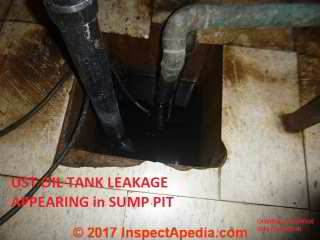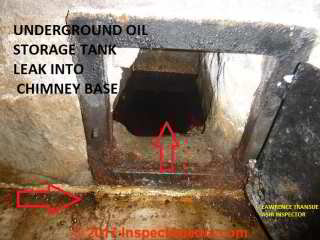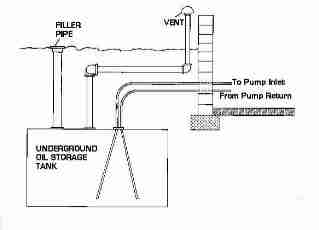 Buried fuel oil tanks
Buried fuel oil tanks
Advice for home owners, buyers, inspectors
- POST a QUESTION or COMMENT about this article topic.
Buried oil storage tank (UST) advice for building owners & buyers:
This article explains residential and light commercial buried oil tanks or other buried heating fuel tanks: environmental concerns, defects, inspection: basic advice for home buyers and home owners where a buried oil tank is or was installed.
We discuss the risks regarding buried oil storage tanks USTs or other buried tanks. We include photographs, a field report of a severe heating oil tank leak into the building, and commentary on detecting leaks or threats of leaks at buried oil storage tanks.
This document provides sample home inspection report language which may assist in advising home owners or home buyers about the risks associated with buried oil or other fuel storage tanks at their property, and which can help explain the need for action and where more information can be obtained.
InspectAPedia tolerates no conflicts of interest. We have no relationship with advertisers, products, or services discussed at this website.
- Daniel Friedman, Publisher/Editor/Author - See WHO ARE WE?
The Buried Oil Tank RIsk: A Home Buyer's Guide to Buried Oil Tanks - The Risk of Oil Leaks Means Risk of Major Cleanup Costs
 If you are purchasing a property where there is or was an oil storage tank that has been abandoned or removed, you should be sure to
If you are purchasing a property where there is or was an oil storage tank that has been abandoned or removed, you should be sure to
read HOME BUYERS GUIDE TO OIL TANKS.
When we observe evidence that a buried fuel storage tank is [or may have previously have been] located at a property and when no other information is known about the type, condition, or even exact location of the tank, underground tank leaks, environmental damage, local water or well contamination, and a costly cleanup are potential risks to the property owne
Because significant site cleanup costs can be involved if an oil tank has leaked at a property, unless there is reliable documentation that the tank has been tested quite recently, it would be prudent for a home buyer to have such testing performed before purchasing the property.
Installing a new oil storage tank will involve significant expense.
There are also proper methods of "abandoning" old unused buried tanks.
Requirements for reporting oil tanks at properties and for reporting heating oil leaks when they are discovered are discussed next, followed by our advice regarding tank inspection, testing, and detection. (C)Copyright trap DJ Friedman.
Before completing purchase of a property that has or had a buried oil tank
you need to have either had the tank removed, abandoned in place, or tested.
The discussion which follows explains the risks and gives detailed advice about what to do about buried or above ground oil tanks and tank leaks.
See REPORTING BURIED OIL TANKS for suggestions of how to report suspected or actual evidence of USTs at a property.
Summary of Oil Leak Reporting Requirements & Oil Tank Registration at Residential Properties
 The NYS Department of Environmental
Conservation, which has regulations similar to those of most U.S. states, has a program requiring the
registration of buried tanks at any site storing
more than 1100 gallons of heating oil.
The NYS Department of Environmental
Conservation, which has regulations similar to those of most U.S. states, has a program requiring the
registration of buried tanks at any site storing
more than 1100 gallons of heating oil.
Though specific reporting details may vary, most U.S. states have similar requirements. Requirements for gas (auto fuel), or other fuels may be different as well.
The presence of a buried (or above ground) oil storage tank at a residential property does not need to be reported to the DEC provided the onsite storage volume is less than 1100 gallons.
However, if an oil leak is detected at any fuel storage tank, indoors, outside above ground, or buried, it must be reported to the Department of Environmental Conservation within two hours. The concern is for leaks which contaminate the environment.
Tanks located where they may leak into a local waterway or into the water supply are a special environmental concerns.
Using a second U.S. state, Maryland, as example, if soil or groundwater contamination is found during oil tank (or presumably any other) excavation, the contamination must be reported to Maryland Department of the Environment immediately upon discovery.
Any residential heating oil storage tank greater than 1,100 gallons in capacity must be required to be registered with MDE.
Heating oil tank regulations vary widely in other U.S. states and in other countries. According to Project Clean Oslofjord in Norway, maintenance checks of buried oil tanks are required initially only to tanks over 3,200 liters.
For oil tanks within the regulated size range, since 1997 owners of such oil storage tanks must have the tanks checked at a frequency that depends on tank type: single- or double-bottomed steel tanks the first check is after 15 years. After the initial test, such tanks shall be checked every fifth year.
For less leak-prone fiberglass tanks (glass fibre reinforced polyester) the tanks must be pressure-tested two years after burial, and afterwards at 30 years.
OIL TANK LEAK & ABANDONMENT REGULATIONS provides a detailed review of oil leak reporting requirements by U.S. state and other areas and provides links to various tank abandonment regulations
How to Find Evidence of Buried Oil Tanks at a Property
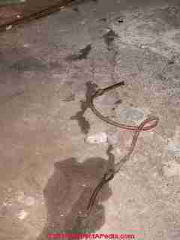
Often an astute inspector can find evidence that there is or still remains a buried oil storage tank at a property even when the fill and vent pipe have been removed and when there is no advance-notification that such a tank was ever present.
Our photo at left was taken in the basement of a home in Portland Maine built around 1900. We see the following items:
- an abandoned heating oil line
- a concrete track in the basement floor marking where an oil line had been installed under the floor after the slab was poured
- water leaking up into the basement through cracks along the oil line routing
Not shown in the photo was a new oil tank installed in this basement.
With just the evidence at hand, we don't know if the prior oil tank which was served by these oil lines was indoors or outdoors. In fact, following the floor cut to the building foundation wall it was easily apparent that the original lines had penetrated the foundation wall to head outside.
This home was previously served by an outdoor underground oil tank or UST.
We still haven't determined if the old oil tank has been properly abandoned or removed - further investigation is in order.
Visual Evidence of Buried Oil Tanks Previously in Use, Possibly Abandoned at a Site
There are many visual clues that will tell us that an oil tank has been in use and abandoned at a property.
Study the photographs that follow for more examples of how to look for evidence of a buried oil tank.
For older properties in areas where use of oil as a heating fuel was common, inspect the building grounds for oil fill or vent pipes. Sometimes an oil filler may be distant from the home, depending on where it was convenient to bury an oil tank; sometimes the oil vent pipe may be nowhere near the oil filler pipe.
Sometimes unscrupulous sellers or agents remove the fill or vent piping from a buried oil tank, taking no other action to properly abandon in place or remove the tank. Don't be afraid to lift flat stones or paint or coffee cans that may be marking an old oil tank filler or vent pipe.
For below-ground oil tanks or USTs, a visual inspection inside of the in-building equipment, foundation walls, and surrounding area may disclose abandoned oil lines, marks where such lines were present, or older gauges or valves used with an outdoor buried oil tank.
For above-ground tanks, a simple visual inspection of the tank and its piping, can give you and idea of the risks involved. Look for obvious leaks such as oil stains on the ground or floor under or around the tank and around the oil fired equipment. Remember to look under the oil tank at its bottom, as most leaks occur in the lower portion of the tank.
Non-Visual Evidence of Buried Oil Tanks Previously in Use, Possibly Abandoned at a Site
Buried Tanks: Look at the property before deciding to hire a tank testing company for professional inspection and testing.
You can obtain basic information such as the age (property and tank), tank location, and type of oil tank. From a previous use, a buried oil tank may be present or may have been present at a property even if it is now served by an indoor, above ground oil tank or even by LP or natural gas.
So don't assume that because you don't see a tank that none was ever used or present at a property.
Make a visual site inspection for clues suggesting that one or more tanks is or was present.
Even when there are no direct visual clues, contextual inspecting and thinking about the history of a building may still suggest that it had or may have had a buried oil tank with sufficient probability that it is worth further investigation to search for a buried tank, or for records indicating that an oil tank has previously been removed. These include:
- History of the property
includes conversion of fuels, perhaps from coal to oil to gas - Presence of an old oil-fired heating
boiler or water heater with a new oil tank installed - Evidence of excavation
outside and close to the building foundation walls, or subsidence in such locations - Seepage of oil
through a building foundation wall (a serious oil leak has been happening) - Oil odors or stains
in a building basement or crawl space where oil-fired equipment is not installed - Freshly cemented-over wall patches,
perhaps painted over, on a building foundation wall of an older home where newer oil or gas fired heating equipment is installed may mark the point where flexible copper oil lines from an outdoor tank penetrated the foundation wall.
Field Report: Photo Tour of Severe Oil Leak into an Older Home
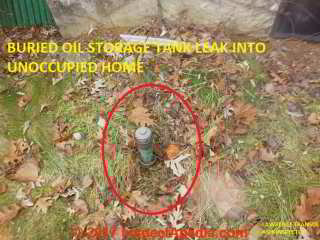 These photographs of severe leakage of heating oil into a home were provided courtesy of ASHI home inspector Lawrence Transue. Mr. Transue is a certified ASHI home inspector and holds other construction credentials as well.
These photographs of severe leakage of heating oil into a home were provided courtesy of ASHI home inspector Lawrence Transue. Mr. Transue is a certified ASHI home inspector and holds other construction credentials as well.
The inspector was engaged to inspect this Pennsylvania property approximately a week after the home had received an oil delivery.
The home, being sold as part of an estate, had been unoccupied for an unknown period of time. At the time of the home inspection this home was 64 years old.
The inspector wrote (2017/12/09):
Here are photos I took today - this home has a leaky buried oil tank. The sump pit was filled with home heating oil and, remarkably, the fireplace clean out opening was also filled with oil.
The home is part of an estate. The estate executor came for the inspection. Oil was delivered to the home last week.
Thanks to these photographs and information from the inspector we have an opportunity to learn about a severe oil tank leak into a building.
Our photograph above shows the heating oil storage tank fill pipe, feeding an underground storage tank of undetermined size, possibly 550 gallons.
In the oil filler photo above there is one possible clue presaging trouble.
No oil tank vent pipe is visible. Perhaps there is a vent line and opening nearby but out of the range of this photograph.
Watch out: if a heating oil storage tank is not properly vented there is a good chance that it can be burst or leak during an oil delivery.
See OIL TANK FILL & VENT PIPING INSPECTION CHECKLIST for details.
Oil storage tanks are normally filled rapidly (about 50 gallons per minute) and at pressure.
Normally a heating oil delivery driver will not deliver oil to a tank that she or he suspects is un-sound.
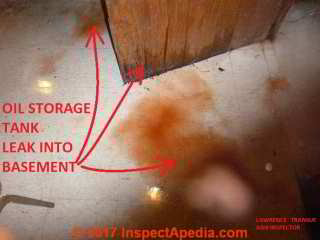 But in this case we speculate that no one knew the condition of the tank, nor had leaks been reported to the oil company. Details are
But in this case we speculate that no one knew the condition of the tank, nor had leaks been reported to the oil company. Details are
In our second oil spill photo from the same home we see heating oil puddled on the basement floor. Notice also that oil has wicked up into the bottom of wood paneling (red arrows).
Watch out: also - estate managers handling an unoccupied home in freezing climates will want to have the home inspected regularly to protect it from costly damage from loss of heat or plumbing leaks.
A home buyer purchasing a home with an oil storage tank of unknown condition needs to have the tank inspected and probably tested.
A leaky oil storage tank must be emptied and the spill cleaned-up - usually a costly procedure.
It is also possible that there is a bit of subsidence over the oil tank.
If so, that also might be a warning sign of a pending tank collapse, especially at an older property.
Watch out: cleaning up spilled oil from a basement floor can be troublesome but it's most-often feasible.
Below is indicator that this property may be facing such a cost: the sump pit is filled with heating oil.
If heating oil has entered this sump pit, apparently by flowing under the building foundation, footings, and floor slab, then this leak is going to be very costly to remediate. State regulations might require removal of the floor slab in order to remove oil-contaminated soil.
Below is another indication that heating oil may have passed under the foundation and floor slab of this home: opening the chimney cleanout at floor level the inspector found that the well in the chimney base was filled with heating oil.
In the photograph our right-pointing arrow suggests that so much oil entered the chimney base that it has overflowed onto the interior floor. (Based on the other photographs of this oil spill shown above, we don't think the oil moved in the opposite direction: across the floor and into the chimney base.)
Watch out: Oil storage tank leaks must be reported under the laws of almost every U.S. state. Regulations concerning oil tank leak reporting, abandonment, cleanup, are
at OIL TANK LEAK REPORTING REGULATIONS - ALL
Could this leaky oil tank have been discovered before this catastrophic in-home oil spill?
Maybe. Or as Mark Cramer, Tampa home inspector says "... it depends." When a home is unoccupied for a long time there is a greater chance trouble develops before anyone notices it.
I've seen water leaks from roof and surface runoff that enter a chimney base from outside. I've also seen leaks into a basement from water collecting in the excavation made to install the buried oil tank.
So it' s not a complete surprise to see this significant oil leak showing up from a badly-leaking UST whose oil seeps under the foundation,under the basement slab, into a sump pit, and also into the chimney cleanout and base.
One can but wonder how long the tank was leaking before it was, perhaps, broken open during the last oil fill (if that's what happened).
- Water in the oil tank:
Water collecting in an underground oil storage tank is a primary cause of corrosion and ultimately, oil tank failure. For this reason, good oil tank maintenance would include a periodic check for water in the tank. Removing accumulated water can extend the tank life, and a finding of a lot of water in an oil storage tank would be a red flag.
In an occupied home if there is a lot of water in an oil storage tank it can begin to find its way to the oil burner. The resulting loss of heat and observation of water in the oil filter canister can be a tip-off of impending water troubles.
Oil tank water testing is not, of course, part of the scope of a home inspection.
See OIL TANK WATER CONTAMINATION. - Increased heating cost:
Often people see their oil bill going up without explanation and above what would be explained by an increase in the number of degree days during a cold heating season. - Abnormal oil tank fill volumes:
On occasion an oil delivery driver notices that she has just pumped 600 gallons into a 550 gallon UST. - Oil odors:
if we eschew what probably happened here - a sudden catastrophic blowout of a rusty oil storage tank - and if we consider that a tank is often leaking for some time before the catastrophe, building occupants may notice a heating oil smell around the home's exterior or in the basement. - Lawrence Transue is a Pennsylvania building scientist and consultant, a certified ASHI home inspector, a Licensed Pesticide Applicator, a BPI Building Analyst & Envelope Professional, with 18 Years of Home Inspection Experience. He can be reached by Telephone: 610.417.0763, by Email: lawrence@lawrencetransue.com as well as at his WEBSITE and at FACEBOOK
Oil Tank Inspection Report Language: Standard, Concise "Buried Tank" Home Inspection Report Language for Buried Oil Tanks
This discussion is now found
Test The Oil Storage Tank: Basic Advice about Testing Buried Oil Tanks
Hire an expert to find hidden or buried tanks, abandoned tanks, or to test existing tanks:
Specialty companies and some oil companies have equipment to test buried tanks for leaks. Tanks and soil around and below tanks are tested for evidence of leakage using:
Common oil tank leak tests listed below can tell you if a tank has already leaked and can help assess the chances of an upcoming oil tank leak. T
he tests are listed here and are discussed in more detail in the document at "More Reading" below.
- Water testing
in oil tanks can indicate the risk of in-tank corrosion and thus leakage - an easy first-pass which can be used at both above ground tanks and buried oil tanks - Soil testing
looks for evidence of actual oil contamination in the soil. A proper soil test is based on having located the buried tank or the site where a tank was buried, and taking borings to a depth approximately just below the tank bottom. - Low-psi tank pressure-testing
is used to test a tank for existing leaks. - Electronic testing
can also screen tanks for evidence of damage - usually this is used only on commercial jobs. - Ground scanning radar or magnetic sensing
(metal detectors) are also used to locate buried steel tanks.
I advise home buyers to have a soil test performed rather than a pressure test of an existing oil tank, since even if the tank is not currently leaking we would prefer an assurance that it didn't leak before, say from a plumbing connection that was repaired.
OIL TANK LEAK TEST METHODS discusses oil tank testing options and procedures in more detail.
Oil Storage Tank Failure Mechanisms: a Summary of Fuel or Heating Oil Storage Tank Failure Mechanisms and Tank Leak Rates
A basic understanding of why oil tanks leak can help you assess the chances that a given tank at a property has already leaked or is likely to leak soon.
Oil tanks can fail and produce costly oil leaks for more reasons than you might think. Water in the tank, not external rust, is the most common culprit.
But other leak causes include mechanical damage that gouges a tank while it's being buried, oil fill, vent, or supply piping errors that leak oil, corrosive soil conditions, manufacturing defects, weather conditions contributing to in-tank condensation, and delivery of bad oil that is contaminated with water.
OIL TANK LEAK / FAILURE CAUSES - "Oil Tank Leaks or Oil Tank Failure Causes - oil tank leaks are caused by corrosion, damage, soil conditions, other factors". This document discusses the causes of above ground and underground oil tank leaks in detail.
Oil Tank Failure Rates
If an underground oil tank at a property is 15-20 years old the chances of a leak are high and you need to have the tank tested.
Even if the tank is not leaking now and has not already leaked, if there is an old, buried steel tank at a property you should plan on replacing it before it leaks not afterwards.
OIL TANK FAILURE DATA - Oil Tank Failure Rates - Oil Tank Leak Probability as a Function of Tank Age, Location, Condition, Soil Conditions and Other Factors. This document describes rate or frequency of oil tank leaks or oil storage tank failures, focused on underground storage tanks or USTs.
Oil Storage Tank Removal or Abandonment: Summary of Tank Removal or Abandonment
Oil Tank still OK:
Even if a buried oil tank at a property is shown not to have leaked and even if it's less than 10 years old, if the tank is not a special lower-risk unit (fiberglass, plastic, or multi-wall) I advise clients to plan to abandon the tank before it has leaked, substituting a near term big expense for a later term major expense.
Oil Tank Leak Insurance:
Oil tank leak insurance has been offered by some oil companies but you'll find them unlikely to write a policy at all on an older high-risk installation.
Oil Tank No Longer in Use
If a fuel storage tank is not to be used, for example if you've converted to another fuel, oil tank removal or oil storage tank "abandonment" can involve significant expense.
"Oil Tank Removal"
means just that, the tank is excavated, emptied, cleaned, and removed from the property - leaving a large hole to be filled-in.
"Oil Tank Abandonment"
means that a tank is left in place, cut open, emptied, cleaned, has its piping removed, and usually filled-in with an approved filler. A proper abandonment procedure involves pumping out remaining fuel, confirming that there has been no leakage, and filling the tank with an approved filler, or removing it entirely.
Typical tank fillers include sand or special foam products to avoid future use or future collapse. These measures, if required, will involve significant expense.
The Oil Tank Leaked:
If a tank has leaked the leak must be reported (in most jurisdictions) even if was a small leak, and the tank needs to be removed. Any oil-contaminated soil must be removed as well and taken to an approved waste site.
...
Reader Comments, Questions & Answers About The Article Above
Below you will find questions and answers previously posted on this page at its page bottom reader comment box.
Reader Q&A - also see RECOMMENDED ARTICLES & FAQs
On 2021-04-07 by (mod) - improperly-abandoned oil tank found at property being bought
@Adam Novitt,
Well it's a bad sign in that we know that the tag was not properly abandoned in that it was left empty rather than filled. Also if you see heating oil at all it would be floating on top of any water in the tank since water tends to fall to the bottom. That tells you that the tank was not cleaned either. In sum, it sounds as if the oil tank has not been properly abandoned.
I would not walk from the purchase, but I also would not conclude the purchase before having appropriate tests for oil tank leaks and contamination at the property.
That means either pressure testing the tank (I'd be scared to do it in this case) or testing soil at a depth of and around the tank bottom to see if there has been oil leakage;
The costs of tank abandonment could pale if in fact there have been leaks that require tank removal and removal of contaminated soil.
So get the right inspections and tests done before completing the purchase.
On 2021-04-07 by Adam Novitt
We found on oil tank on property we are buying. the building hasn't been heated with oil on more than 20 years but the tank appears to be full of liquid, well above the water table. It's oil at the top at least. Is this a good or a bad sign?
On 2021-03-07 by Anonymous
Thank you so much for your quick reply. I'll let my parents know!
On 2021-03-07 - by (mod) -
@Diane,
With the original oil tank abandonment documentation lost, in my OPINION it's not worth one nanosecond trying to prove that the original work was done properly except by taking the normal step of having an onsite inspection and soil testing for leaks.
If the soil tests are conducted properly, by an independent, un-biased professional and if those results show that no oil leaks were detected, that ought to be the end of the issue.
If I were the buyer, I'd want tests done to a depth of the bottom of the oil tank.
On 2021-03-07 by Diane
Hi, My parents are selling their house and they have a buried oil tank on their property. Decades ago they switched to gas. They had the oil tank emptied and filled with sand, but unfortunately all of the documentation was lost in a flood in their basement. Potential buyers are asking for proof that the tank has been remediated properly.
The buried oil tank exists under a patio. Does anyone know of a way that my parents can prove that the tank has been filled with sand, ideally without dismantling the patio? Thanks.
On 2020-05-16 - by (mod) -
Anon
Anon:
Ultimately you'll be able to cut off that oil storage tank vent pipe or better, simply unscrew and remove it.
But wait a bit:
First, it is important to determine that your oil storage tank was properly emptied, cleaned, and abandoned when it fell from use. If you ignore this step the risks include later discovering that you face a very expensive oil leak cleanup that could have been avoided, or worse there is a collapse and someone is injured.
I bring up the warning because it is unusual to abandon and empty and clean an oil storage tank properly while leaving a vent pipe installed on the tank. That's because normally the tank would have been cut open and filled with sand, gravel, or the like.
But of course it's possible that the vent isn't right over the tank.
Ask for help from an environmental inspector or oil tank removal company before you proceed.
On 2020-05-16 by Anonymous
We recently purchased a house. There is a pipe in the backyard that is obviously a few oil vent pipe it has a cap on it. We want to put in a walkway and wants to know if we can cut this pipe off at the ground level? The house has been run on an HVAC system for over 30 years and there have been several owners since then.
On 2020-01-06 by TRUTON BEHEER B.V.
To Whom It May Concern,
We are pleased to bring to your notice that we have Tanks available for lease. Our Tank Farm have durable and reliable tanks storage facilities at head office {Elbe 42 3144 DR Maassluis / Rijnmond West} Rotterdam, Our tank farm is a Crude/Petroleum reservoir with high storage capacities located in all ports of the Netherlands (Rotterdam) Port.
Our Team of competent experts are always interested in giving to you one of the best services and total product security guaranteeing your satisfaction and securing our values. Contact us today for our services and have your products in safe custody.
Please Note: That we also have some product already stored in our Tanks by some sellers for urgent lift.
Please contact us via our official email address.
TRUTON BEHEER B.V.
Official Email: info@trutonbv.com
Alternative Email: rotterdam@trutonbv.com
Website: www.trutonbv.com
Skype ID: TRUTON BEHEER B.V.
Tel:+31-635-259-623
On 2019-09-23 - by (mod) -
Joseph
The answer to who is allowed to abandon an underground oil storage tank depends on regulations where you live.
But I'd take care in any event: you want some proof - a test by a qualified, independent expert - that the oil tank has not already leaked. Otherwise you risk a very expensive snafu down the road should the property be up for sale, and you could risk violating the law (depending again on where you live).
For example most U.S. states and Canadian provinces require that if an oil tank HAS leaked that leak must be reported to the appropriate environmental agency and it must be cleaned-up.
So just cutting open, pumping out, and filling in the oil tank aren't the concern. The concern is making sure there's no leakage and having that documented.
On 2019-09-22 by Joseph
Can I legally fill a underground oil tank that's no longer in use with an appropriate filler myself and make it legally abandoned?
On 2019-05-08 - by (mod) -
Marcy
"Can you" is of course a bit broad - of course you can = but we have no information about your historical house including its country, city, (thus regulations), construction, location of the oil tank, and difficulty of access to the site; special care may be needed to avoid damaging the foundation during tank removal.
And there may be additional site access restrictions for a historical site - adding to oil tank removal costs.
But, then, why are we removing the oil tank? If it has leaked it must be removed and the spill cleaned-up.
If the tank has not leaked (prove by testing) then it may make more sense to abandon the tank in place. See OIL TANK ABANDONING PROCEDURE in the ARTICLE INDEX above.
On 2019-03-20 by Marcy
Can you remove a buried fuel tank in a historical house built in the 1600's? It is now a restaurant.
...
Continue reading at BURIED OIL TANK HISTORY REVIEW or select a topic from the closely-related articles below, or see the complete ARTICLE INDEX.
Or see OIL TANK, BURIED, FAQs - questions and answers posted originally on this page.
Or see these
Recommended Articles
- BURIED OIL STORAGE TANKS (UST) GUIDE - home
- OIL TANK LEAKS & SMELLS - home
- OIL TANK REPLACEMENT PROCEDURE
- OIL TANK TESTING & REMOVAL COs
- OIL or SEPTIC TANKS FLOATING UP
- OIL TANK WATER CONTAMINATION
- OIL TANKS - home
- SPHERICAL OIL STORAGE TANKS - the HORTON SPHERE
Suggested citation for this web page
OIL TANK, BURIED, ADVICE at InspectApedia.com - online encyclopedia of building & environmental inspection, testing, diagnosis, repair, & problem prevention advice.
Or see this
INDEX to RELATED ARTICLES: ARTICLE INDEX to HEATING OIL, OIL BURNERS, OIL FIRED HEATERS, OIL TANKS
Or use the SEARCH BOX found below to Ask a Question or Search InspectApedia
Ask a Question or Search InspectApedia
Questions & answers or comments about buried oil storage tanks - for building owners or for people buying a building that has or had a buried tank
Try the search box just below, or if you prefer, post a question or comment in the Comments box below and we will respond promptly.
Search the InspectApedia website
Note: appearance of your Comment below may be delayed: if your comment contains an image, photograph, web link, or text that looks to the software as if it might be a web link, your posting will appear after it has been approved by a moderator. Apologies for the delay.
Only one image can be added per comment but you can post as many comments, and therefore images, as you like.
You will not receive a notification when a response to your question has been posted.
Please bookmark this page to make it easy for you to check back for our response.
IF above you see "Comment Form is loading comments..." then COMMENT BOX - countable.ca / bawkbox.com IS NOT WORKING.
In any case you are welcome to send an email directly to us at InspectApedia.com at editor@inspectApedia.com
We'll reply to you directly. Please help us help you by noting, in your email, the URL of the InspectApedia page where you wanted to comment.
Citations & References
In addition to any citations in the article above, a full list is available on request.
- Mancuso, Anne & Mueller, Benjamin, "2 Workers Die When a Backyard Fuel Tank Explodes in Westchester County", The New York Times, 8 May 2015, p. A19.
- [1] Fuel Storage] Tank Corrosion Study, U.S. EPA report on gasoline and oil tank corrosion, James H. Pim, P.E., John M. Searing, Suffolk County DOHS, 15 Horseblock Place, Farmingville Long Island, NY 11728, November 1988, for the Office of Underground Storage Tanks, U.S. EPA. ATTN: David O'Brien. The report presents a study of 500 underground storage tanks spanning 24 February 1987 and September 1 1988 and summarizes earlier reports on this same study. Tank sizes ranged from 175 gallons to 50,000 gallons, and oil tank ages ranged from two years to 70 years old. All 500 oil storage tanks were constructed of welded steel, and 12 other tanks that were other than plain steel were also examined. Summary [with minor edits for clarity by DJF] n Guidance for Design and Installation of Underground Oil Storage Tanks", U.S. EPA, EPA/530-SW-85203, Office of Underground Storage Tanks, Washington D.C.,
- [9] US EPA "How do you Properly Close a UST?" is summarized at epa.gov/OUST/fsprevnt.htm These details for temporary and permanent closing of underground oil storage tanks are provided by the US EPA as well.
- [10] "How do you choose the right tank testing method?", Cynthia Johnson, Fuel Oil & Oil Heat Magazine, November 1995
- [11] National Association of Oil Heat Service Managers, PO Box 380, Elmwood Park, NJ 07407
- [12] "Homeowners Guide to Fuel Storage," Agway Energy Products, Verbank, NY, November 1990
- [13] "Causes of Underground Corrosion", Harco Corporation, Paper HC-36, Median OH
- National Association of Oil Heat Service Managers, PO Box 380, Elmwood Park, NJ 07407
- "Homeowners Guide to Fuel Storage," Agway Energy Products, Verbank, NY, November 1990
- In addition to citations & references found in this article, see the research citations given at the end of the related articles found at our suggested
CONTINUE READING or RECOMMENDED ARTICLES.
- Carson, Dunlop & Associates Ltd., 120 Carlton Street Suite 407, Toronto ON M5A 4K2. Tel: (416) 964-9415 1-800-268-7070 Email: info@carsondunlop.com. Alan Carson is a past president of ASHI, the American Society of Home Inspectors.
Thanks to Alan Carson and Bob Dunlop, for permission for InspectAPedia to use text excerpts from The HOME REFERENCE BOOK - the Encyclopedia of Homes and to use illustrations from The ILLUSTRATED HOME .
Carson Dunlop Associates provides extensive home inspection education and report writing material. In gratitude we provide links to tsome Carson Dunlop Associates products and services.


